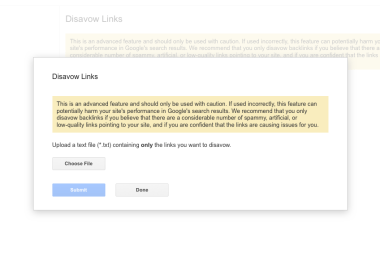Negative SEO is something of a boogeyman. Some will say it doesn’t exist. Some say it exists, but it’s largely ineffective. Some are in awe of its power, claiming it’s capable of taking down even top ranked sites. Still others claimed to have personal experience with it, either as a victim or as part of a history with black hat SEO. On black hat forums, it’s regarded with reverence, just another tool in the toolbox.
The way negative SEO works is by simulating unnatural link building activity against other sites. By showing Google that thousands of junk links are being built in an attempt to manipulate your website’s rankings, it’s possible that Google can penalize and/or deindex your site completely – when you have done nothing wrong.
Whether or not it’s a threat, and whether or not it’s effective at trashing a young site, it’s worth taking steps to immunize your site against it.
Why?
Simple: the techniques used to protect yourself against negative SEO are, for the most part, the same techniques you use to build positive SEO. Think of it like a number line, with a brand new site starting at zero. If you build up to 15, the -10 hurts, but doesn’t leave you in the hole while a hit of -10 from a position of 1,000 may not even be felt. By building an authority site, Google will know it’s less likely that you’re manipulating rankings with junk links, and your rankings will be less likely to plummet from these attacks.
So, to protect yourself from negative SEO, take up the following tips and put them into use. Many of these tips work equally well on a new or an established site, though some are basic steps for building a new site.
Establish Website Security
The most dangerous, and most insidious, negative SEO attacks are those performed through hacking your site.

Any breach of your security is bad, but it’s made even worse when the hacker does nothing overt. It’s one thing when they take down your pages, trash your databases and vandalize your account. It’s quite another when all they do is insert a few hidden spam links on your pages, install themselves as an admin user and leave. If they worked quickly and quietly, you might not even notice until you start receiving penalties for bad links or hidden text.
To prevent this kind of attack, make sure your passwords are strong and unique. Make sure your host has up to date web security, and that any infrastructure you have installed is up to date. This means, in particular, keeping WordPress and any commerce platform you use updated. Use security plugins as well, whenever possible. The additional security won’t hurt.
If your blog is going to have multiple authors, or you have other people working on your site but who don’t need admin access, limit the permissions on their accounts. Only those who absolutely need admin access should have it.
Create and Use Social Profiles
To combat negative SEO, you need to build traffic, links and an audience. One of the primary ways to do this is through social media. Social media marketing is far too complex a subject to cover in a subsection of a single article, but suffice it to say creating your profiles and keeping them active is a good start.

For a brand new site, you probably don’t need more than just the basic Facebook-Google+-Twitter combo.
The goal is to establish yourself a presence and reputation independent of your own site. No negative SEO attack, no matter how powerful, is going to cause Twitter to drop from the rankings.
An active set of social profiles also helps keep you in contact with your users, if your site is attacked and brought down or force off the first page.
Implement Authorship
Even though Google cut out the primary incentive many webmasters had for establishing Authorship – that is, the profile pictures in search results – they didn’t cut all value from the service. Authorship is designed to give you as an author a reputation separate from that of your site.
Ideally, with Authorship, you will be able to establish more of a reputation as a legitimate blogger and webmaster. If your site is a victim of negative SEO, you can maintain Authorship as a sign of legitimacy. In a sense, you’re telling Google that, hey, this isn’t your fault, you’re trying to fix the problem. It might not do much, but every bit helps.
Create Content in Volume
Every piece of content is important to your site. Content pulls in links. Content attracts users. Content provides value that keeps users coming back. Content also provides landing pages for the negative SEO links that bombard your site in a linkspam attack.
It’s important to have a high volume of content, even right out of the gate. Sites with few pages are easier to hit with negative SEO, for a couple of reasons. First, fewer pages means that one page going down is a higher percentage of the site going down. Second, fewer pages means fewer legitimate incoming links to balance out the negative links. Lastly, “thin” sites are typically lower quality and spammier, which could give Google the wrong impression when your site starts receiving a ton of junk links.
If possible, start your blog at five posts per week, one each weekday. This gives you weekends to prepare and deal with other tasks, while still maintaining a high volume of content. Of course, all of your content needs to meet the standards of the web. Make sure it’s high quality, sufficiently long, and deep enough to provide unique value and insight.
Build Organic Links
Organic links come in all shapes and sizes, with a range of varied anchor text, from both high and lower quality sites and in both followed and nofollowed forms. A varied and robust link profile is necessary to combat a linkspam attack, which tends to focus on a single set of anchor keywords and a few bad domains. Their weapon is volume; yours is quality and variety.
Be Proactive with Disavowing Links
Google’s Disavow Links tool is about the only actual Google-provided resource you have to combat negative SEO.

Be proactive in using it. Make sure you have Google Analytics attached and verified, and keep an eye on your incoming links. If you begin to notice hundreds or thousands of unexpected incoming links from bad domains, make note of those domains.
Rather than disavowing individual links, make use of Google’s function for disavowing entire domains.
This way, if you have 1,000 incoming links from various subpages on one domain, you can disavow them all with one entry.
This can save an incredible amount of time, and catches any future links from that domain.
Improve Any Targeted Pages
When you’ve reached a certain critical mass on your site in terms of content, you’ll notice any negative SEO attack tends to target weak points. They’re trying to point out flaws in your site and make it harder to distinguish between where the negative SEO attack ends and the natural flaws in your site begin. Scrutinize which pages they’re targeting and take steps to improve them.
Build an Online Reputation
Take the time to network with other bloggers in your industry, particularly those with established sites and positive reputations. You don’t want to accidentally reach out to the shady competitor buying the negative SEO attack. You also don’t want to cloister yourself off and avoid outside contact altogether.
By building a robust online reputation, you gain the trust of other bloggers, who will be more willing to assist you in recovering your site. They won’t be able to do all the work for you, of course, but they can offer a well-placed link to help you on your way. They may also have advice of their own from dealing with an attack, which might help you.
In the end, the only way to truly prevent a negative SEO attack is to be too strong to bring down. Unfortunately, the only way to reach that level is with a significant amount of time and investment. Your goal is to make it through the vulnerable early stages of website growth as quickly and as legitimately as possible.
Image Credits
Featured Image: Jason Baker via Flickr (Creative Commons)
Image #1: Christophe Verdier via Flickr (Creative Commons)
Image #2: Jason Howie via Flickr (Creative Commons)





